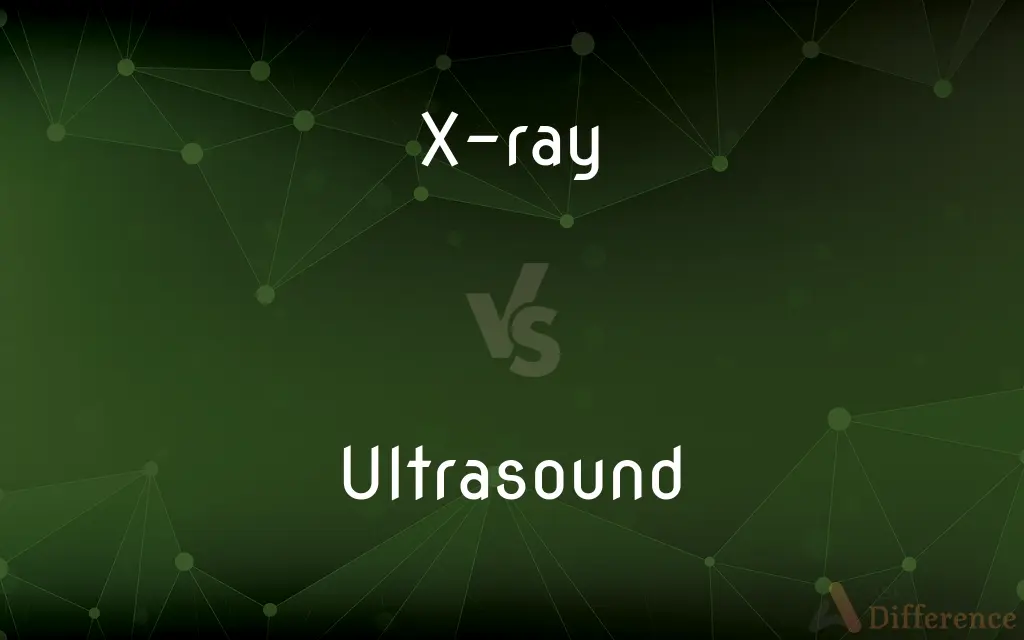X-ray vs. Ultrasound — What's the Difference?
Edited by Tayyaba Rehman — By Fiza Rafique — Published on December 10, 2023
X-ray uses ionizing radiation to produce images of internal structures, while Ultrasound employs sound waves to visualize soft tissues and organs.

Difference Between X-ray and Ultrasound
Table of Contents
ADVERTISEMENT
Key Differences
X-ray is a form of electromagnetic radiation that can penetrate and be absorbed by body tissues to different extents, creating a shadow image on a detection plate. Ultrasound, on the other hand, utilizes high-frequency sound waves which bounce off tissues and are then captured to produce real-time images.
In terms of safety, X-rays involve a small amount of ionizing radiation, which can pose risks with prolonged or excessive exposure. Ultrasound is considered safer because it uses non-ionizing sound waves and doesn't expose patients to radiation.
The clarity and detail of an X-ray image rely on the density of the tissues being examined; bones, being denser, appear white, while less dense tissues appear darker. Ultrasound is especially effective in visualizing soft tissues, fluid-filled structures, and organs, giving detailed images of their shape and structure.
While X-ray is frequently used for visualizing bones, detecting lung and chest disorders, or finding tumors, Ultrasound is commonly employed for examining the abdomen, obstetric evaluations, cardiac assessments, and guiding certain medical procedures.
The equipment for X-ray typically consists of an X-ray machine and a detection plate or film. Ultrasound employs a device called a transducer which emits and detects the sound waves, and the images are displayed on a monitor in real-time.
ADVERTISEMENT
Comparison Chart
Type of Energy
Electromagnetic radiation (ionizing)
High-frequency sound waves (non-ionizing)
Common Use
Bones, chest, tumors
Soft tissues, pregnancy, cardiac evaluations
Safety
Small radiation exposure
Generally considered safe
Image Production
Based on tissue density
Based on sound wave reflection
Real-time Imaging
No
Yes
Compare with Definitions
X-ray
A form of electromagnetic radiation used for imaging.
The doctor ordered an X-ray to check for a possible fracture.
Ultrasound
A diagnostic imaging technique using sound waves.
The Ultrasound showed the baby's heartbeat.
X-ray
A way to identify abnormalities in hard tissues.
Dental X-rays help identify cavities between teeth.
Ultrasound
A non-ionizing procedure for internal examinations.
The doctor recommended an Ultrasound over an X-ray to avoid radiation.
X-ray
A diagnostic tool detecting variations in tissue density.
The X-ray revealed a spot on her lung.
Ultrasound
A method to visualize soft tissues in real-time.
She had an Ultrasound to examine her liver.
X-ray
A method that uses ionizing radiation for visualization.
Protective aprons are worn during an X-ray to minimize radiation exposure.
Ultrasound
A tool often used in obstetrics to monitor fetal development.
The couple saw their baby for the first time on the Ultrasound screen.
X-ray
A technique to examine internal structures without surgery.
With an X-ray, they identified the foreign object inside.
Ultrasound
A technique guiding certain medical procedures.
The surgeon used Ultrasound guidance for the biopsy.
X-ray
A photon of electromagnetic radiation of very short wavelength, ranging from about 10 down to 0.01 nanometers, and very high energy, ranging from about 100 up to 100,000 electron volts.
Ultrasound
Ultrasonic sound.
X-ray
Often x-rays or X-rays A narrow beam of such photons. X-rays are used for their penetrating power in radiography, radiology, radiotherapy, and scientific research. Also called roentgen ray.
Ultrasound
The use of ultrasonic waves for diagnostic or therapeutic purposes, specifically to image an internal body structure, monitor a developing fetus, or generate localized deep heat to the tissues.
X-ray
A photograph taken with x-rays.
Ultrasound
An image produced by ultrasound.
X-ray
The act or process of taking such a photograph
Did the patient move during the x-ray?.
Ultrasound
(physics) Sound with a frequency greater than the upper limit of human hearing, which is approximately 20 kilohertz.
X-ray
To irradiate with x-rays.
Ultrasound
(medicine) The use of ultrasonic waves for diagnostic or therapeutic purposes.
X-ray
To photograph with x-rays.
Ultrasound
(ambitransitive) To treat with ultrasound.
X-ray
Examine by taking x-rays
Ultrasound
Very high frequency sound; used in ultrasonography
X-ray
Take an x-ray of something or somebody;
The doctor x-rayed my chest
Ultrasound
Using the reflections of high-frequency sound waves to construct an image of a body organ (a sonogram); commonly used to observe fetal growth or study bodily organs
Common Curiosities
Can Ultrasound show real-time movements?
Yes, Ultrasound displays real-time images, showing movements and activities of the body.
What kind of energy does an X-ray use?
X-ray uses ionizing electromagnetic radiation.
Can Ultrasound detect blood flow?
Yes, Doppler Ultrasound specifically captures blood flow and heartbeats.
What's the primary risk associated with X-rays?
The main risk with X-rays is the exposure to ionizing radiation.
Can X-rays be used in dental examinations?
Yes, dental X-rays are common to identify tooth decay and other dental issues.
How should patients prepare for an X-ray?
Generally, wearing loose-fitting clothing and removing jewelry; specific preparations depend on the type of X-ray.
How does Ultrasound produce images?
Ultrasound uses high-frequency sound waves that reflect off tissues to produce images.
Is there any radiation exposure with Ultrasound?
No, Ultrasound uses non-ionizing sound waves, so there's no radiation exposure.
Why might a doctor choose an X-ray over an Ultrasound?
A doctor might choose an X-ray for its ability to clearly visualize bones or detect lung disorders.
What is a common use for Ultrasound in obstetrics?
Ultrasound is commonly used to monitor fetal development during pregnancy.
Is Ultrasound safe during pregnancy?
Generally, Ultrasound is considered safe during pregnancy when used appropriately.
How does the Ultrasound device capture images?
A transducer emits sound waves, captures their reflections, and translates them into images on a monitor.
Why might a patient need a chest X-ray?
To detect lung disorders, infections, tumors, or to evaluate the heart's size and shape.
Can Ultrasound guide medical procedures?
Yes, Ultrasound is often used for guidance in procedures like biopsies.
Do X-rays provide detailed images of soft tissues?
No, X-rays are best for visualizing bones and certain abnormalities but not detailed soft tissue imaging.
Share Your Discovery

Previous Comparison
Internal Economies of Scale vs. External Economies of Scale
Next Comparison
Inert Gases vs. Noble GasesAuthor Spotlight
Written by
Fiza RafiqueFiza Rafique is a skilled content writer at AskDifference.com, where she meticulously refines and enhances written pieces. Drawing from her vast editorial expertise, Fiza ensures clarity, accuracy, and precision in every article. Passionate about language, she continually seeks to elevate the quality of content for readers worldwide.
Edited by
Tayyaba RehmanTayyaba Rehman is a distinguished writer, currently serving as a primary contributor to askdifference.com. As a researcher in semantics and etymology, Tayyaba's passion for the complexity of languages and their distinctions has found a perfect home on the platform. Tayyaba delves into the intricacies of language, distinguishing between commonly confused words and phrases, thereby providing clarity for readers worldwide.














































